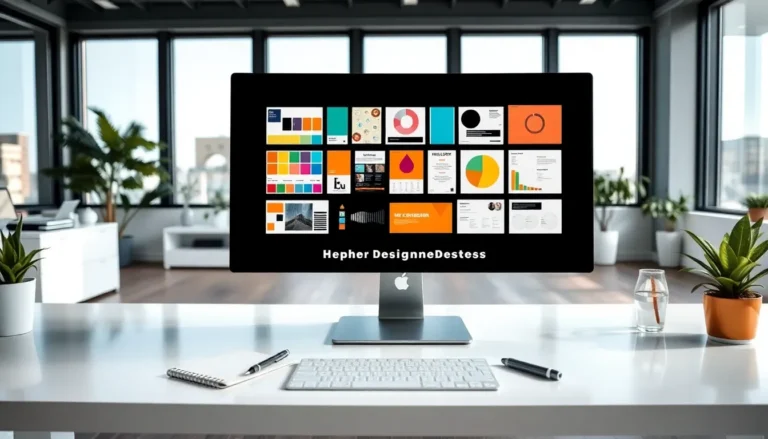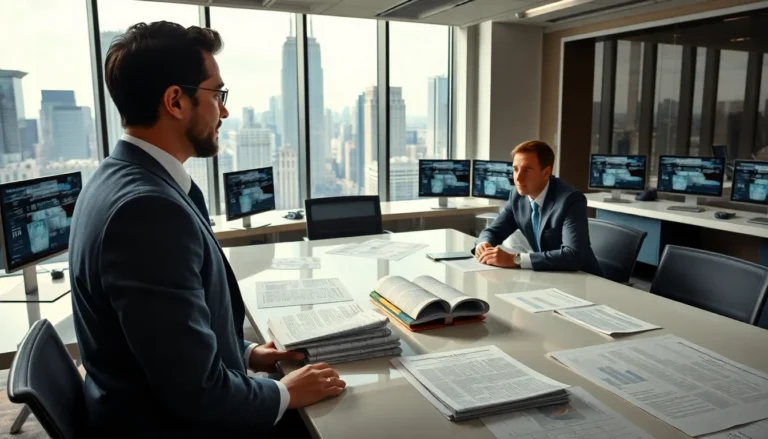Table of Contents
ToggleWhen it comes to interior design, it’s not just about slapping some paint on the walls and calling it a day. It’s a thrilling adventure that transforms ordinary spaces into extraordinary havens. Imagine walking into a room that feels like a warm hug or a stylish runway—now that’s the magic of great design.
Overview of Interior Design Concepts
Interior design encompasses various elements that contribute to creating harmonious and functional spaces. Concepts such as color theory, spatial arrangement, and furniture selection play vital roles in shaping an interior environment.
Color theory affects mood and perception. Warm tones often evoke energy, while cool shades instill tranquility. Selecting the right colors for different areas can enhance the overall atmosphere.
Spatial arrangement ensures effective use of space. Designers consider flow and functionality when positioning furniture and decor. Thoughtful layouts promote accessibility and comfort, transforming crowded areas into open, inviting environments.
Furniture selection influences aesthetics and utility. Each piece serves a specific purpose beyond mere decoration. Designers prioritize quality, durability, and style when choosing furniture, aiming for cohesion within the overall design.
Styling approaches greatly vary, with options like minimalist, eclectic, or traditional. Minimalism emphasizes simplicity and functionality, while eclectic designs blend diverse elements for a unique touch. Traditional styles often highlight classic elegance through rich fabrics and intricate details.
Lighting design enhances the visual appeal and functionality of spaces. Ambient, task, and accent lighting each serve distinct purposes. Proper lighting can significantly alter the perception of a room’s size and warmth.
Sustainability has become increasingly important in interior design. Eco-friendly materials and practices contribute to healthier living environments. Many designers prioritize sustainable sourcing and energy-efficient solutions, bridging aesthetics with ecological responsibility.
Exploring these concepts reveals the intricate nature of interior design. Each aspect intertwines to create spaces that resonate with individual preferences and lifestyles.
Types of Interior Design Concepts
Several interior design concepts shape the overall look and functionality of a space. They include functional design, aesthetic design, and sustainable design, each contributing to a well-rounded interior.
Functional Design
Functional design prioritizes usability and efficiency within a space. Spaces must accommodate daily activities, ensuring that elements are accessible and practical. For instance, open floor plans facilitate movement and interaction among spaces. Storage solutions play a crucial role, helping to maintain organization without sacrificing style. Choosing quality materials enhances durability, as well as adds to the room’s overall functionality. Moreover, well-thought-out lighting solutions improve visibility and comfort, making an environment more user-friendly.
Aesthetic Design
Aesthetic design focuses on the visual appeal of an interior. It encompasses style choices, color palettes, and decorative features that create a specific atmosphere. Mixing textures and patterns can add depth to a room, captivating the eye and enhancing the space’s allure. Artists and designers often draw inspiration from various sources, enabling eclectic styles that reflect individual tastes. The strategic placement of art and décor invites conversation, making areas more inviting and engaging for guests. Furthermore, balance in color schemes ensures a harmonious look, establishing a cohesive aesthetic throughout the design.
Sustainable Design
Sustainable design emphasizes eco-friendly practices and materials. The use of renewable resources minimizes environmental impact, promoting both health and sustainability. Choosing recycled materials reduces waste and energy consumption, while also providing unique textures and finishes. Incorporating energy-efficient lighting further supports sustainability goals, lowering utility costs and enhancing long-term value. Plants in the interior improve air quality, contributing to an overall healthier living environment. Advocating for sustainable practices fosters awareness, encouraging a shift towards more responsible design choices.
Key Elements of Interior Design
Interior design encompasses several key elements that contribute to the overall aesthetic and functionality of a space. Understanding these components is essential for creating inviting environments.
Color Schemes
Color schemes play a vital role in shaping the atmosphere of a room. Warm colors, such as reds and oranges, stimulate energy and creativity, while cool colors, like blues and greens, promote calmness and relaxation. Selecting cohesive color palettes enhances visual appeal. Designers often consider the psychology behind colors, ensuring they align with the desired mood of the space. For example, a serene bedroom may utilize soft blues and whites, fostering tranquility. Creating balance through contrasting hues can add depth and interest, guiding the eye throughout the room.
Furniture Selection
Furniture selection combines form and function to enhance the usability of a space. Prioritizing the right pieces ensures comfort and complements the overall design theme. Quality materials contribute to durability and aesthetic value. Sofas, chairs, and tables serve as focal points, so choosing styles that harmonize with the color scheme matters. Space affects furniture arrangement, promoting ease of movement. Mixing textures can create visual interest too, marrying elegance with practicality. Accessories, like throw pillows and rugs, provide opportunities for personal touches while maintaining cohesive design.
Lighting Techniques
Lighting techniques enhance the ambiance and functionality of interior spaces. Layering light sources, including ambient, task, and accent lighting, creates dynamic environments. Ambient lighting fills a room with overall illumination, while task lighting focuses on specific areas, like desks or kitchen counters. Accent lighting highlights artwork or architectural features, adding depth. Selecting appropriate fixtures further shapes the mood. Dimmers offer flexibility, allowing users to adjust brightness according to activity. Natural light impacts energy and mood, making window treatments crucial for maximizing sunlight while maintaining privacy.
Trends in Interior Design Concepts
Contemporary interior design showcases evolving trends that redefine space aesthetics and functionality. Minimalism and biophilic design represent two significant movements reshaping modern environments.
Minimalism
Minimalism emphasizes simplicity and functionality. Clean lines and uncluttered spaces create serene atmospheres. Color palettes often feature neutral tones, allowing for subtle texture variations. Furniture pieces are streamlined, promoting efficient usage without overwhelming the space. Decorative items are kept to a minimum, focusing on essential elements that provide both form and function. This trend encourages individuals to prioritize quality over quantity, leading to intentional living environments that foster calmness and clarity.
Biophilic Design
Biophilic design connects indoor spaces with nature, enhancing well-being. Natural light plays a crucial role, illuminating rooms and reducing reliance on artificial sources. Incorporating plants improves air quality while providing visual appeal. Natural materials like wood and stone bring organic warmth into interiors, fostering a calming atmosphere. Views of outdoor landscapes from within create a sense of tranquility. This approach promotes emotional health by reminding inhabitants of their connection to the natural world, ultimately enriching the living experience.
Exploring interior design concepts reveals the intricate balance between functionality and aesthetics. By understanding the impact of color theory spatial arrangement and furniture selection individuals can create spaces that reflect their unique tastes and enhance their daily lives. Embracing contemporary trends like minimalism and biophilic design further enriches the living experience fostering a sense of tranquility and connection to nature.
As design evolves it’s essential to stay informed about sustainable practices that not only benefit the environment but also contribute to a healthier home. Ultimately interior design is about more than just beautifying a space; it’s about crafting an environment that nurtures well-being and inspires creativity.







